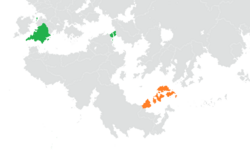Latium-Pulau Relations
 | |
Latium |
Pulau Keramat |
|---|---|
| Diplomatic mission | |
| Embassy of The Latin Emperor, Kopiona Poi | Embassy of Pulau Keramat, Castellum |
| Envoy | |
| Ambassador Marcus Pollius | Ambassador Syariel Shirong |
Latium-Pulau Keramat Relations are primarily defined by their nearby spheres' of influence and commercial exchange. Relations between the two countries span as early as 10th century and the Tahamaja period of Ozeros history. Contemporary relations between the two are defined by their ideological differences and geopolitical identities that shape regionalistic attitudes.
Official relations between the two nations is standard, with a permenant embassy for the new confederation established in 1978, and the Pulaui Embassy being repurposed from its original position in Castellum. Formal relations are kept at a formal minimum of globalized procedure, given the radically deviant political and economic environments between the two nations; however, since the turn of the 21st century, regional sociopolitcal conflict within the area has placed the two nations in more explicit interaction with one another, such as the Fahrani Civil War and the Gran Aligonian Crisis.
A majority of interaction between the Pulaui Archipelago and the Empire occur within the proximity of Perateia, giving its boundary position between the Periclean and Ozeros. Political and historical analysists have tied this region as being perceived as the overlap of spheres of influence to both nations; in the historical presence and security ensured by Latin within the Periclean, and the rapid Pulau expansion and unification of the Ozeros through mediums such as the Association of Malaio Ozeros Nations and the Vespanian Exchange Institute. Because of this, periphery nations like Vardana, and Fahran often see proximity relations in terms of support, influence, and geopolitical engineering as both percieved spheres overlap in the Northern Ozerosi Basin. This interaction has also led to interesting sociocultural diffusion on aspects of religious presence, avenues of commercial exploration, and migratory populations within Perateia.
History
Medieval Cross-Cultural Interactions
Early historical analysis of serious, impactful interaction stems from mercantile movement by the Tahamajan thalassocracy into the Periclean after the Asing Mesa Declaration of expansion and exploration. Primarily results of this exchange included the movement of citrus, spices, and fabrics into the Periclean that had not yet been made available, as well as the return of wines, olives, and oils that would be used in substitute to the endemic substances used in Tahamajan Shipbuilding. Given a majority of the early Latinic Empirical rule occurs within the Western corridors of the Periclean, a majority of political interaction at this time was shared with the Vardanan Empire and Bayarid Empire, yet this extension of religious and cultural exchange would remain an influencial part of the Perateian straits, in the establishment of ethnic conclaves and the development of diffusive culinary habits, such as the utilization of 'Sambal' from Pulaui Cuisine in traditional dishes, such as in Gyros, Pizzas, Paellas, and other savory dishes adopted from mainland Latium. Still, most interaction during this period was indirect, and through the exchange of goods and recollections by other merchants that would act as a transitory medium between the two.
Instances of naval warfare and conflict were uncommon, albeit not unheard of between eastern-reaching Latinic fleets and expansionary Tahamajan missions; with recorded instances in both peaceful exchange and trade being as anticipated as skirmishes, seemingly dependent on the type of vessel and proximity to the straits themselves. The absence of the Tahamajan interactions also corresponds largely to records taken after the Siriwang Eruption, which remarkably caused a near global volcanic winter in 1353. This retraction of naval forces, both as a result of oceanic disturbances and social tensions over failing crops, would be the end of medeival relationships between the two regions; especially as the Belfrasian Crusade had begun to demand attention to the West, in Oxidentale and Norumbia.
Contemporary Relations
Periclean-Ozerosi Exchange
Commercial Relations
(TBC)
Cultural Relations
(TBC)